
Atlanta
The Diocese of Atlanta: A 65th anniversary timeline
Published August 10, 2021
ATLANTA—On July 2, 1956, the Diocese of Savannah-Atlanta was split into two separate dioceses: Savannah and Atlanta. The historical timeline commemorates the 65th anniversary of the diocese highlighting its shepherds, ministries and remarkable growth. The timeline is condensed from the Interactive StoryMap of the Office of Archives and Records, “Finding Your Roots in Faith: A History of the Archdiocese of Atlanta.”
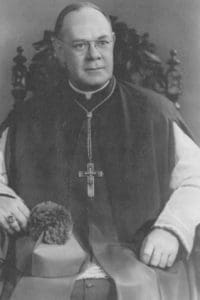
Bishop Francis E. Hyland
Bishop Francis E. Hyland, 1956-1961
Francis E. Hyland, auxiliary bishop of Savannah-Atlanta, was named the new Bishop of Atlanta and installed on Nov. 8. After his appointment as bishop in 1956, he served five years until he resigned in 1961 due to failing health. He died on Jan. 31, 1968.
Office of Catholic Schools
When the Diocese of Atlanta was formed, the Office of Catholic Schools was established with Father Cornelius Maloney as the first superintendent. Work began on establishing new diocesan schools, including the state’s first co-ed Catholic high school, Saint Pius X, in 1958. Two elementary schools opened in the late 1950s. Catholic education would continue to expand into the next decade.
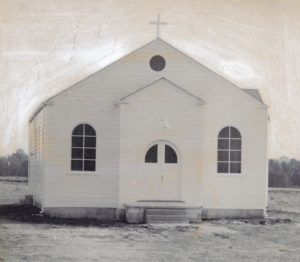
Original church for St. Anna Church, located at 836 E. Spring St, Monroe, photographed in 1957.
Rural Ministry
Soon after its establishment, the Diocese of Atlanta continued expanding into the rural parts of north Georgia, beginning in 1957 with the dedication of a chapel for the St. Anna mission in Monroe. Over the next five years, new chapels were dedicated in seven communities. The diocese was short on priests, so Bishop Hyland asked religious orders to assist in ministry.
Archbishop Paul J. Hallinan, 1962-1968
On Feb. 10, 1962, the Diocese of Atlanta was elevated to an Archdiocese. Pope John XXIII selected Bishop Paul J. Hallinan to be the first Archbishop of Atlanta, who was installed on March 29. He contracted hepatitis in 1963 and never fully recovered, although he continued serving the faithful until he died in office on March 27, 1968.
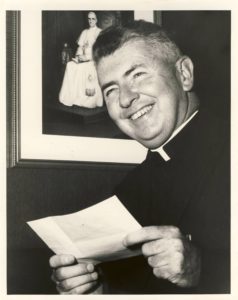
Archbishop Paul J. Hallinan
The Georgia Bulletin
In September 1962, Archbishop Hallinan announced the creation of the Archdiocese of Atlanta’s new newspaper, The Georgia Bulletin. The new paper traced its routes to 1920 when the Catholic Laymen’s Association of Georgia began publishing The Bulletin meant to dispel anti-Catholic sentiment that pervaded the South at the time. As Catholicism became more accepted in the South, The Bulletin continued publishing news, particularly in relation to new parishes and clergy assignments. When the Diocese of Savannah-Atlanta split into two dioceses, the newspaper likewise split into two editions. Archbishop Hallinan envisioned a re-branded newspaper focusing on telling the important news of the day through the lens of Catholic teaching.
Civil Rights
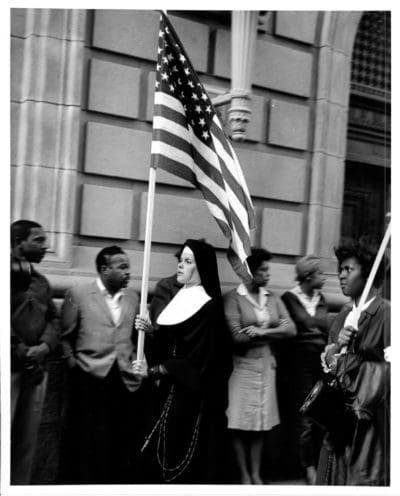
Sister Kathleen Robert, CSJ., teacher at St. Anthony School, marched at a demonstration in Atlanta supporting voting rights and denouncing police brutality on March 16, 1965.
Throughout the 1960s, the Archdiocese of Atlanta and Archbishop Hallinan advocated for civil rights. Soon after arriving in Atlanta, he ordered the integration of all diocesan schools. After the first classes were integrated that September, Hallinan in a press release lauded all the “priests, teachers, parents, and children” who “proved themselves good citizens and good Christians, good members of the mature, progressive community in which we live.” The following year, Catholic hospitals were integrated. Archbishop Hallinan was the only white Christian leader to sponsor the banquet in honor of Dr. Martin Luther King Jr.’s Nobel Peace Prize in 1965. That same year, Hallinan approved six priests from the archdiocese to join protests in Selma, Alabama in favor of voting rights.
Second Vatican Council/First Archdiocesan Synod
From October 1962 to December 1965, Catholic bishops and clergy met at four sessions at the Vatican to address the church’s liturgy and dogma in relation to the modern world. Archbishop Hallinan attended all sessions and pushed for using the vernacular in Mass. After the Council’s conclusion, Hallinan tasked the archdiocese with implementing the changes presented at the Vatican. He convoked the First Archdiocesan Synod in 1966 to reflect on the diocese’s first 10 years and plan for the future. The Formal Synod took place in November 1966.
School Accreditation
At the Synod, Secretary of Education Father Daniel J. O’Connor called for the accreditation of Catholic schools with the Southern Association of Colleges and Schools. He argued that accreditation was necessary for Catholic schools to compete with public schools, particularly through hiring and retaining qualified staff. Catholic schools had been facing a teacher shortage due to the decline in Catholic Sisters, who had been stalwarts of Catholic education.
Auxiliary Bishop Joseph L. Bernardin, 1966-1968
Due to Archbishop Hallinan’s illness and the growing needs of the Archdiocese, Pope Paul VI appointed Atlanta’s first auxiliary bishop, Joseph L. Bernardin, on March 9, 1966. He served as Apostolic Administrator of the archdiocese after Archbishop Hallinan’s death in April 1968. Three months later, he was appointed General Secretary of the National Conference of Catholic Bishops and resigned his position in Atlanta. He went on to serve as Archbishop of Cincinnati and Archbishop of Chicago. He was elevated to the College of Cardinals in 1983.
Archbishop Thomas A. Donnellan, 1966-1987
Following the death of Archbishop Hallinan, Bishop Donnellan was appointed by Pope Paul VI as the second Archbishop of Atlanta on May 29, 1968. His installation on July 16, 1968 began a 19-year tenure, during which he would guide the archdiocese through extensive growth. Archbishop Donnellan’s tenure began during a challenging time in Georgia history. His appointment and installment came shortly after the assassination of Martin Luther King Jr. and during the middle of the Vietnam War.
Population Growth
During Donnellan’s tenure as archbishop, the number of Catholics in North Georgia tripled from 50,000 in 1968 to over 133,000 in 1987, adding a total of 32 new parishes. While the state as a whole saw an increase in population, the counties directly adjacent to the metro Atlanta saw the greatest increase of residents. Of the new parishes opened during this time, 16 were in these newly accessible Atlanta suburbs.
School Integration
Part of Archbishop Donnellan’s pledge when he was installed was to continue Hallinan’s work for the Civil Rights Movement, including advancing school integration efforts.
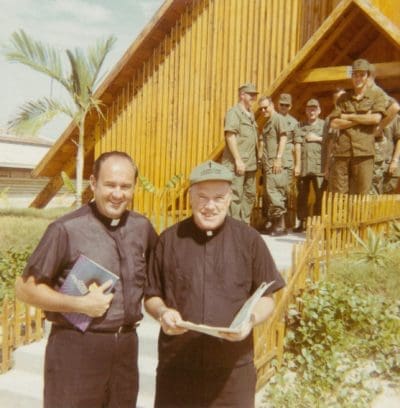
Archbishop Donellan, right, visiting with chaplains in Vietnam during a trip to provide retreats.
Vietnam War and Archbishop Donnellan’s Trip
U.S. involvement in the Vietnam War began in the mid 1950s and continued until the complete withdrawal of troops in 1975. In December of 1970, Archbishop Donnellan was asked by the Chief of Chaplains, U.S. Army, if he would be willing to travel to Vietnam to preach several retreats to the Catholic chaplains of our Armed Forces. He agreed and in September 1971, he flew to Hawaii where he offered his first retreat. He left Hawaii on an Army chartered flight for Vietnam to lead retreats in Saigon and Cam Ranh Bay. In between retreats, he celebrated Mass at the Saigon Cathedral, and met with the apostolic delegate, as well as the Archbishop of Saigon.
The Vietnamese Apostolate
With the end of the Vietnam War in 1975, and the fall of Saigon to the People’s Army of Vietnam, more than 130,000 Vietnamese closely associated with the United States and the former government of South Vietnamese were quickly evacuated and resettled in the United States. Correspondence between Archbishop Donnellan and the USCCB Migration and Refugee Services shows that the archdiocese helped sponsor and provide resettlement opportunities for 46 families in August of 1975.
Economic hardship and ongoing wars between Vietnam, China and Cambodia led to a second migration of people seeking safety and a way to escape between 1978 and 1979. A 1979 report from the Vietnamese Apostolate estimated over 1,800 Vietnamese refugees were living in Georgia, with 1,000 of those refugees residing within the archdiocese. In 1976 Archbishop Donnellan established the Vietnamese Apostolate and assigned Father Francis Pham Van Phuong to be a chaplain to incoming refugees. By 1979, The apostolate served over 75 Catholic Vietnamese families in the Atlanta area.
Catholic Schools Decline
The 1970s marked a period of decline for Catholic schools nationwide due in part to lower enrollment as the Baby Boom generation surpassed school age. Additionally, the continuing decline in Catholic Sisters staffing schools led to an increasing reliance on higher salaried lay teachers. In the Archdiocese of Atlanta, the push for accreditation required limiting the ratio of students to teachers, which meant either hiring more staff or limiting enrollment. The increased costs associated with each scenario resulted in no new Catholic schools and eight closed schools in the Archdiocese between 1965 and 1986.
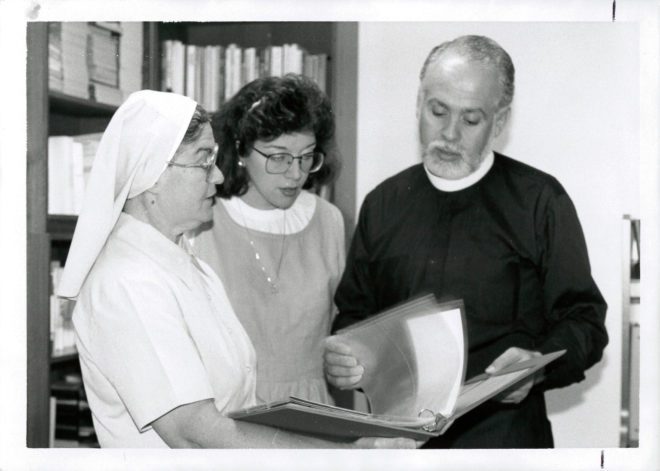
Sister Pilar Dalmau, ACJ., outgoing director of the Office of Hispanic Apostolate, left, reviewed materials with new director Susana Jimenez and new Vicar for Hispanics, Father Edward Salazar, SJ From The Georgia Bulletin: Aug. 4, 1988
Hispanic Immigration
From 1950 to 1980, the arrival of Cuban refugees in Atlanta led to a large Hispanic population. At the beginning of the 1980s, Cubans made up 53 percent of the Hispanic population followed by South Americans (17%) and Mexicans (11%). The Hispanic population grew tremendously over the next three decades from 26,765 in 1982 to 108,029 in 1990 and to 240,592 in 2000. In 1976, the first Hispanic Catholic Ministry was founded at Christ the King Cathedral.
Hispanic Apostolate
In 1982, the Chancery formed the Hispanic Apostolate and named Father William Hoffman as its first director. The Hispanic Apostolate worked to ensure Spanish Masses were offered in many parishes throughout the Archdiocese of Atlanta. Many immigrants, including a large number of Hispanics, began to relocate to the Chamblee-Doraville area. The growing population of Hispanic-Americans in Chamblee led to the establishment of the Archdiocesan Hispanic Pastoral Council. In 1988, Sister Pilar Dalmau became the acting Director of the Hispanic Apostolate. She began working closely with the AHPC to help visit the homes of Latinos and to determine what needs they had.
Archbishop Eugene A. Marino, 1988-1990
From Sept. 12, 1974 until 1988, Archbishop Marino was an auxiliary bishop for the Archdiocese of Washington (D.C.), as well as becoming the secretary of the National Conference of Catholic Bishops in 1985. With his installation as the Archbishop of Atlanta on May 5, 1988, he became the first African American Archbishop in the United States. On July 10, 1990 Archbishop Marino resigned his position. He died in New York on Nov. 12, 2000.
Archbishop James P. Lyke
Archbishop James P. Lyke, OFM. came to Atlanta in 1990 as the Apostolic Administrator for the archdiocese and ran the day-to-day business of the church until he was officially installed as the fourth Archbishop of Atlanta on June 24, 1991. At the time of his death from cancer on Dec. 27, 1992, Archbishop Lyke was the highest-ranking African American clergyman in the United States. During his lifetime, he played a part in the Black Catholic Movement and was President of the National Black Catholic Clergy Caucus. He also served on the administrative board and committee of the U.S. Conference of Catholic Bishops. The results of some of his efforts are a hymnal project that led to Lead Me, Guide Me: The African American Catholic Hymnal and the establishment of the Black Liturgy Subcommittee of the Bishops’ Committee on Liturgy.
Founding of the Archives
In the fall of 1992, only a few months before his death, Archbishop Lyke officially established the Archives for the Archdiocese of Atlanta. Anthony “Tony” Dees was hired as the first archivist and served in that role until 2001. He made great strides in pulling together existing stashes of records and in actively collecting materials relating to the historic patrimony of the Catholic Church in north Georgia.
Archbishop John F. Donoghue, 1993-2004
Archbishop John F. Donoghue was named the fifth Archbishop of the Archdiocese of Atlanta in 1993 and installed on Aug. 19 that same year. He served North Georgia faithfully until his retirement on Dec. 9, 2004. On Nov. 11, 2011, Archbishop-emeritus Donoghue died at the age of 83.
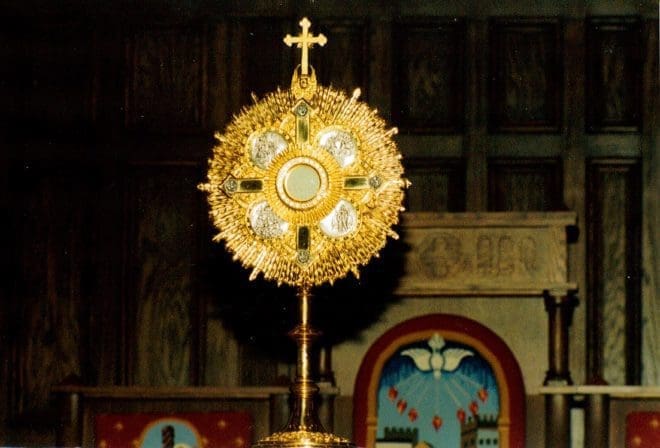
A monstrance at the Eucharistic Renewal in June 1996 which began at Holy Spirit Church.
Eucharistic Congress
When appointed to Atlanta, Archbishop Donoghue made the center of his pastoral work among Catholics to renew understanding of and devotion to the Eucharist as the Real Presence of Christ. On June 9, 1996, an overflowing crowd of more than 1,000 people gathered at Holy Spirit Church in Atlanta on the feast of Corpus Christi for the first Eucharistic Renewal. For several years the annual Eucharistic Renewal alternated locations between Holy Spirit Church and the Cathedral of Christ the King until the decision was made to move the event to the newly opened Georgia International Convention Center (GICC) in 2001. The larger venue was a gamble and the volunteer committee running the Congress was unsure if they’d made the right decision. Some 12,000 people showed up for that first Eucharistic Congress in the GICC on June 16, 2001. The event continued to grow, and the Eucharistic Congress traditionally attracts more than 30,000 people each year. The event resumes in 2022 and will take place every other year with a focus in the alternate years on parish celebrations.
Building the Church of Tomorrow
In March 1997, the Archdiocese of Atlanta launched a major capital campaign called “Building the Church of Tomorrow” to raise $50 million with pledges spread over a five-year period. Archbishop Donoghue announced the unprecedented campaign saying “the Church of the South is growing so rapidly that unless we do something we are not going to be able to provide for the needs of our people.” The funds were targeted for construction of new schools, expanded ministries and the creation of endowments to support seminarian education and the retirement of priests. Many parishes linked local fund raising efforts to the archdiocesan campaign and also invested in renovations or new church buildings. The campaign had reached over $102 million in pledges a year after its launch. By the end of the capital campaign in 2003, six new archdiocesan schools were built, many parishes had made improvements and endowment funds had been created.
Catholic Schools Boom
By the 1990s, the troubles facing Catholic schools the previous two decades had largely subsided. Rapid population growth in the Atlanta area—particularly in the suburbs—brought more Catholics to the region. Demand for Catholic schools had increased, and long wait lists were common. With the launch of the “Building the Church of Tomorrow” campaign in 1997, the Archdiocese committed to increasing access to Catholic education. Five new schools opened by the end of 2000.
Archbishop Wilton D. Gregory, 2005-2019
On Jan. 17, 2005, a month after Archbishop Donoghue retired, Archbishop Wilton D. Gregory was installed as the sixth Archbishop of Atlanta. Archbishop Gregory served in many leading roles in the U.S. Catholic Church. In November 2001, he was elected president of the U.S. Conference of Catholic Bishops following three years as vice president. During his tenure in office, the crisis of sex abuse by clergy escalated and, under his leadership, the bishops implemented the “Charter for the Protection of Children and Young People.” Archbishop Gregory wrote extensively on church issues, including pastoral statements on the death penalty, euthanasia/physician-assisted suicide, and numerous articles on the subject of liturgy, particularly in the African American community.
Continuing on the foundation of Archbishop Donoghue, he continued promoting the annual Eucharistic Congress, established 12 parishes and seven missions to accommodate growth, expanded the Office of Intercultural Ministries to minister to the diverse community, and actively encouraged and participated in ecumenical and inter-religious initiatives. On May 21, 2019, he was installed as the seventh Archbishop of Washington. At the Nov. 28, 2020 Consistory in Rome, Cardinal Gregory was elevated by Pope Francis to the College of Cardinals becoming the first ever African American Cardinal.
Auxiliary Bishop Luis R. Zarama, 2009-2017
Bishop Luis R. Zarama, a priest for the archdiocese,was ordained as auxiliary bishop of the Archdiocese of Atlanta. He served in this role for eight years until he was named sixth bishop of the Diocese of Charlotte, North Carolina.
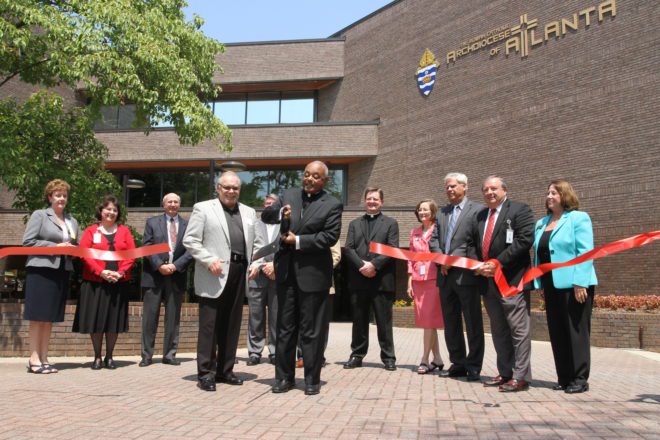
Smyrna Mayor Max Bacon, foreground left, Cobb County Chamber of Commerce Ambassador Barbara Woodhouse, background, far left, and members of the Secretariat joined Archbishop Wilton D. Gregory, holding scissors, for the ribbon cutting ceremony during the Chancery grand opening, August 24, 2011. Photo by Michael Alexander
New Chancery Building
In 2011, after months of renovation, the Chancery for the archdiocese moved its location to 2401 Lake Park Drive in Smyrna. The Chancery staff had outgrown the original West Peachtree location in downtown Atlanta several years prior, and the newer headquarters allowed for a consolidation of offices.
Auxiliary Bishop David P. Talley, 2013-2016
Bishop David P. Talley, an archdiocesan priest, was ordained to the episcopacy as an auxiliary bishop for Atlanta on April 2, 2013. He served until Sept. 21, 2016 when he was appointed Coadjutor Bishop of Alexandria, Louisiana. On April 2, 2019, Bishop Talley was installed as the sixth Bishop of Memphis, Tennessee.
Environmental Initiatives
Leading the response to “Laudato Si’: On Care for our Common Home” (Pope Francis’ encyclical on the environment and human ecology), the archdiocese joined with scientists and advocates to develop the first of its kind Laudato Si’ Action Plan. Ongoing activities include sharing ideas with other faiths, promoting discussion through radio, documentaries, social media, and speaking engagement, supporting parish and school energy audits, and implementing parish care for creation teams. With an eye to the future and the goal of a more sustainable culture, the archdiocese is building on past accomplishments to more fully incorporate Laudato Si’ into parishes, schools, institutions and into the lives of the faithful.
Pastoral Plan
A major contribution to the current and future health of the archdiocese is the Pastoral Plan. Promulgated by Archbishop Gregory in 2015, the Pastoral Plan focuses on the future of the local Catholic Church by strengthening the archdiocese’s efforts in four specific areas: Knowing Our Faith, Living Our Faith, Spreading/Keeping Our Faith, and The Evolution of Our Parishes. The five-year plan included discussion points for parishes and parishioners to discern and improve upon their faith, to discover ways to become more active in their faith community, to evangelize and spread the faith, and to move the focus back on to parish life by reallocating archdiocesan resources to parishes.
Auxiliary Bishop Bernard E. Shlesinger III, 2017-Present
Ordained as an auxiliary bishop for the archdiocese on July 19, 2017, Bishop Bernard “Ned” E. Shlesinger III was born and raised in the Washington, D.C., area. An Air Force pilot, Bishop Ned left the military in 1990 to pursue his vocation to the priesthood and was ordained as a priest for the Diocese of Raleigh, North Carolina. Bishop Shlesinger is also the director of priest personnel for the Archdiocese of Atlanta.
Auxiliary Bishop Joel M. Konzen, SM, 2018-Present
Bishop Joel M. Konzen, SM, a Marist priest and educator, was named an auxiliary bishop in 2018 and then ordained on April 3. On May 24, 2019, after the installation of Archbishop Gregory as the Archbishop of Washington, the college of consultors elected Bishop Konzen as the diocesan administrator of the archdiocese, a position he retained until the installation of Archbishop Hartmayer.
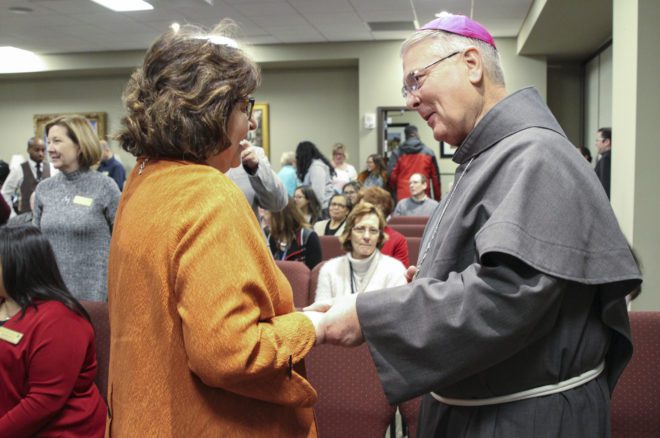
Archbishop-designate Gregory John Hartmayer, OFM Conv., was welcomed and congratulated by Diane Starkovich Ph.D., the Atlanta Archdiocese’s superintendent of schools in March 2020. In his earlier career, Archbishop Hartmayer was also an educator, serving both as a teacher and principal. Photo By Michael Alexander
Archbishop Gregory J. Hartmayer, OFM Conv., 2020-Present
On March 5, 2020, the joyful news of a new Archbishop of Atlanta was announced by Pope Francis. The Bishop of Savannah, Bishop Gregory J. Harmayer, OFM Conv., was named the seventh Archbishop of Atlanta and was welcomed back to the archdiocese. He had previously served as pastor of two Atlanta-area parishes. Due to COVID-19, the typical large celebration surrounding the installation was not possible. Instead a private, livestreamed ceremony took place on May 6, 2020 at the Cathedral of Christ the King.
COVID-19
Facing an unprecedented situation, the Archdiocese of Atlanta worked to adjust to the changing environment of the COVID-19 era. The pandemic began slowly in early 2020, but rapidly spread throughout the world. On March 13, a dispensation from the obligation to attend Sunday Mass was given, followed by a suspension of all public Masses that continued through late May. In-person worship resumed on Pentecost. Archbishop Hartmayer issued a statement on COVID-19 vaccines in December 2020.
The Office of Archives and Records designed the interactive StoryMap—an immersive history of the Catholic community’s unique experiences. To visit the Interactive StoryMap, go to archatl.com/offices/archives/.